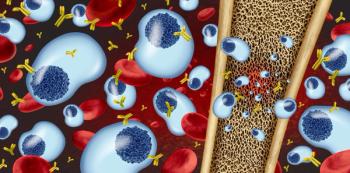
Pharmacy Practice in Focus: Health Systems
- July 2015
- Volume 4
- Issue 4
Protein S Deficiency
Protein S deficiency is a type of inherited thrombophilia associated with increased risk of venous thromboembolism.
Case
A 27-year-old white woman with a past medical history of intravenous drug abuse and hepatitis C presented to the emergency department with a 4-day history of severe chest pain, shortness of breath, and vomiting. She had been admitted earlier in the month with methicillin-resistant Staphylococcus aureus (MRSA) endocarditis and signed herself out against medical advice without completing antibiotic therapy. Blood cultures confirmed MRSA and she was again diagnosed with MRSA endocarditis. Pharmacy staff performed medication reconciliation and all home medications were resumed, including Xarelto (rivaroxaban). Pharmacy staff did not see an indication for Xarelto and investigated further.
Answer
Upon investigation, pharmacy staff discovered the patient had a diagnosis of protein S deficiency. Protein S deficiency is a type of inherited thrombophilia associated with increased risk of venous thromboembolism (VTE). Protein S is an endogenous vitamin K—dependent anticoagulant that acts as a nonenzymatic cofactor for activated protein C (aPC).1 The primary effect of aPC is to inactivate coagulation factors Va and VIIIa, which help activate factors II and X, respectively. Inactivating factors II and X halts the clotting cascade; however, a deficiency in protein S would diminish this effect and cause a procoagulant state.1
Is Xarelto the best therapeutic option for this patient? Given the patient’s history of noncompliance with her antibiotic and anticoagulation/ antithrombotic therapy, warfarin would not be a good option due the importance of compliance with the medication, the need for bridging anticoagulation, and the required periodic international normalized ratio monitoring.2 Xarelto is a factor Xa inhibitor, and newer agents such as oral direct thrombin and factor Xa inhibitors are gaining in popularity for the treatment of VTE and for VTE prophylaxis in patients without inherited thrombophilia. There are no data that prove the newer agents are any less safe or effective than warfarin treatment in these patients.
Since the patient is of childbearing age and warfarin is pregnancy category X, warfarin would not be a good option. Pradaxa (dabigatran), a direct thrombin inhibitor, would be a safe and effective option; however, it requires twicedaily dosing for VTE prophylaxis, which would present a compliance issue for this patient. Eliquis (apixaban), a factor Xa inhibitor, is a pregnancy category B drug, but it also requires twice-daily dosing and would pose a compliance issue for this patient.1-3 The pharmacist concluded that Xarelto, which is pregnancy category C, was the best therapeutic option for this patient due to its once-daily dosing for VTE prophylaxis, lack of monitoring requirements, and more desirable pregnancy category.
Jerry Barbee, PharmD, BCPS, is a clinical pharmacist at HCA West Florida Hospital. Jaclyn Chessher, PharmD, is a clinical pharmacist at HCA West Florida Hospital. Ambree Gober is a 2015 PharmD candidate at Auburn University’s Harrison School of Pharmacy. Matt Savoie is a 2015 PharmD candidate at Auburn University’s Harrison School of Pharmacy.
References
- Witt DM, Nutescu EA, Haines ST. Venous thromboembolism. In: DiPiro JT, Talbert RL, Yee GC, Matzke GR, Wells BG, Posey LM, eds. Pharmacotherapy: A Pathophysiologic Approach. 8th ed. New York, NY: McGraw-Hill Medical; 2011:311-352.
- Guyatt GH, Akl EA, Crowther M, Gutterman DD, Schunemann HJ. Executive summary: antithrombotic therapy and prevention of thrombosis, 9th ed: American College of Chest Physicians Evidence-Based Clinical Practice Guidelines. Chest. 2012;141(suppl 2):e7S-e47S. doi:10.1378/chest.1412S3.
- Apixaban, dabigatran, rivaroxaban, warfarin. In: Clinical Pharmacology [online database]. Tampa, FL: Elsevier Gold Standard, Inc; 2015. www.clinicalpharmacology-ip.com/default.aspx.
Articles in this issue
over 10 years ago
Pain Management: The Pharmacist's Evolving Roleover 10 years ago
New Drugs Health-System Pharmacists Should Knowover 10 years ago
Provider Status Dominates Pharmacy Policy Agendaover 10 years ago
Antimicrobial Stewardship Efforts Advance in US Health Systemsover 10 years ago
Entyvio by Takeda Pharmaceuticalsover 10 years ago
ASHP 2015 Summer Meetings: Takeaways for Health-System PharmacistsNewsletter
Stay informed on drug updates, treatment guidelines, and pharmacy practice trends—subscribe to Pharmacy Times for weekly clinical insights.





















































































































































































































